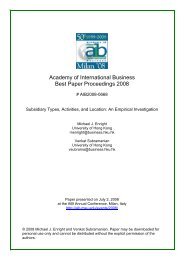AIB 2012 Conference Proceedings - Academy of International ...
AIB 2012 Conference Proceedings - Academy of International ...
AIB 2012 Conference Proceedings - Academy of International ...
Create successful ePaper yourself
Turn your PDF publications into a flip-book with our unique Google optimized e-Paper software.
MONDAY<br />
use <strong>of</strong> knowledge principles is likely to increase responsiveness; while templates are likely to increase project<br />
efficiency. Analyzing 267 globally dispersed consulting projects; we find support for our hypotheses. In general,<br />
this research highlights the importance <strong>of</strong> human capital in the proactive replication process and the<br />
performance effects <strong>of</strong> utilizing different knowledge replication forms. (For more information, please contact:<br />
James Oldroyd, Sungkyunkwan University, Korea, South: oldroyd@skku.edu)<br />
Session: 2.2.6 - Competitive<br />
Track: 4 - Strategy, Alliances, and Competitiveness<br />
M&A, IJV’S and <strong>International</strong> Alliances<br />
Presented On: July 2, <strong>2012</strong> - 10:45-12:00<br />
Chair: Yves Doz, Insead<br />
Exploring the Strategic Antecedents <strong>of</strong> Alliance Portfolio Configuration—An Empirical Study Based on A Two-<br />
Dimension Based Approach<br />
Wei He, Florida <strong>International</strong> University<br />
Sumit K. Kundu, Florida <strong>International</strong> University<br />
Jinlin Zhao, Florida <strong>International</strong> University<br />
Aiming at investigating the determinants <strong>of</strong> alliance portfolio configuration we develop a two-dimensional<br />
typology that incorporates both alliance attributes and partner attributes to demarcate different types <strong>of</strong> alliance<br />
portfolio. The resulting four types <strong>of</strong> alliance portfolio are employed for theory building. Drawing on resourcebased<br />
view and resource dependency theory, we develop a framework demarcating the determinants <strong>of</strong> alliance<br />
portfolio configuration. The resulting conceptual model explains how alliance management experience,<br />
organizational slack and brand image interacting with degree <strong>of</strong> internationalization and environmental<br />
munificence can affect the type <strong>of</strong> alliance portfolio configuration selected by a firm. The empirical results<br />
suggest that the type <strong>of</strong> alliance portfolio chosen by a firm depends on the level <strong>of</strong> the above factors as well as<br />
their interaction with the focal firm's degree <strong>of</strong> internationalization. Overall, this paper shed insights on how<br />
alliance portfolio configuration can be defined and predicted. (For more information, please contact: Wei He,<br />
Florida <strong>International</strong> University, USA: whe001@fiu.edu)<br />
Cross Border Acquisition Choice in the Services Sector: Evidence from Emerging Economies<br />
Somnath Lahiri, Illinois State University<br />
B. Elango, Illinois State University<br />
Sumit K. Kundu, Florida <strong>International</strong> University<br />
Corporate acquisition <strong>of</strong> emerging economy firms by foreign MNEs have been increasing over the years. Yet our<br />
knowledge <strong>of</strong> such cross-border acquisitions (CBAs), particularly those in the services sector, remains limited. In<br />
this paper we examine how acquirer's country-<strong>of</strong>-origin, type <strong>of</strong> service, and cultural distance influence<br />
ownership choice decisions in CBA in emerging economies. Analysis <strong>of</strong> a sample <strong>of</strong> 609 CBAs undertaken in<br />
multiple emerging economies over a 11-year time period by MNEs from 45 nations provide evidence that the<br />
direct and combined effects <strong>of</strong> country-<strong>of</strong>-origin, service type, and cultural distance does impact choice <strong>of</strong><br />
partial versus full acquisition in significantly different ways. We conclude by discussing theoretical and<br />
managerial contributions <strong>of</strong> the study and highlighting limitations and directions for future research. (For more<br />
information, please contact: Somnath Lahiri, Illinois State University, USA: slahiri@ilstu.edu)<br />
Which Came First, The Chicken or the Egg Using Propensity Score Matching to Determine Causality<br />
Wenjie Chen, George Washington University<br />
Alvaro Cuervo-Cazurra, Northeastern University<br />
<strong>AIB</strong> <strong>2012</strong> <strong>Conference</strong> <strong>Proceedings</strong><br />
Page 131

















